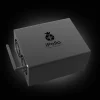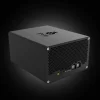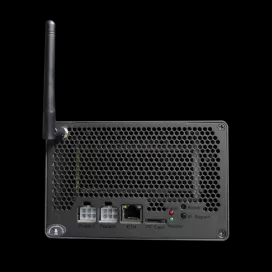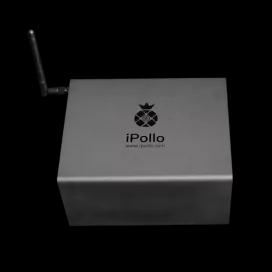What Are the Environmental Requirements for Ipollo V1 Mini SE Plus Operation?
The Ipollo V1 Mini SE Plus is a compact, high-performance miner designed specifically for Ethereum Classic (ETC) mining. With a hashrate of 400 MH/s and a power consumption of just 240W, this device stands out as an efficient and versatile solution for both home-based and professional mining operations. However, like any mining equipment, its performance and longevity depend heavily on the environmental conditions in which it operates. In this article, we’ll explore the environmental requirements for the Ipollo V1 Mini SE Plus, providing practical insights and actionable tips to optimize its operation.
Understanding the Importance of Environmental Conditions
Cryptocurrency mining hardware generates significant heat during operation, and managing this heat is critical to maintaining performance and preventing hardware failure. The Ipollo V1 Mini SE Plus is engineered with advanced thermal management features, but its efficiency can still be compromised if operated in unsuitable conditions. Additionally, factors like humidity, dust levels, and airflow can impact the miner’s reliability and lifespan. By understanding and addressing these environmental factors, miners can ensure consistent performance and maximize their return on investment.
Optimal Temperature Range: Keeping It Cool
One of the most critical environmental factors for the Ipollo V1 Mini SE Plus is temperature. The device is designed to operate within a temperature range of 5°C to 25°C (41°F to 77°F). Staying within this range ensures that the miner’s internal components function efficiently without overheating.
Why Temperature Matters
Heat is a natural byproduct of mining operations, and excessive heat can lead to thermal throttling, reduced performance, and even hardware failure. The dual-fan cooling system in the V1 Mini SE Plus is highly effective at dissipating heat, but it relies on the surrounding environment to maintain optimal temperatures. Operating the miner in a hot or poorly ventilated space can strain the cooling system, reducing its effectiveness.

Practical Tips for Temperature Management
- Choose a Cool Location: Place the miner in a well-ventilated area with ambient temperatures below 25°C. Avoid direct sunlight or proximity to other heat-generating devices.
- Use External Cooling: In warmer climates, consider using air conditioning or additional fans to maintain a cool environment.
- Monitor Temperature: Regularly check the miner’s operating temperature using the built-in monitoring tools or third-party software.
Humidity Levels: Striking the Right Balance
Humidity is another key factor that affects the performance and longevity of the Ipollo V1 Mini SE Plus. The device can operate in environments with humidity levels ranging from 10% to 90%, but extreme humidity can pose challenges.

The Impact of Humidity
High humidity can lead to condensation inside the miner, increasing the risk of corrosion and electrical shorts. On the other hand, extremely low humidity can cause static electricity buildup, potentially damaging sensitive components.
Practical Tips for Humidity Control
- Avoid Damp Areas: Keep the miner away from areas prone to moisture, such as basements or bathrooms.
- Use a Dehumidifier: In humid climates, a dehumidifier can help maintain optimal humidity levels.
- Monitor Humidity: Use a hygrometer to track humidity levels and make adjustments as needed.
Dust and Air Quality: Protecting Internal Components
Dust and airborne particles can accumulate inside the miner, clogging fans and heat sinks, and reducing cooling efficiency. Over time, this can lead to overheating and hardware damage.

Minimizing Dust Exposure
- Clean the Environment: Ensure the mining area is clean and free of dust. Regular cleaning can prevent dust buildup.
- Use Filters: Consider installing air filters to reduce the amount of dust entering the miner.
- Inspect and Clean the Miner: Periodically inspect the miner’s fans and vents, and clean them as needed to maintain optimal airflow.
Airflow and Ventilation: Maximizing Cooling Efficiency
Proper airflow is essential for maintaining the temperature of the Ipollo V1 Mini SE Plus. The device’s dual-fan cooling system relies on a steady supply of cool air to dissipate heat effectively.
Ensuring Adequate Airflow
- Avoid Enclosed Spaces: Place the miner in an open area with ample space around it. Avoid placing it in closed cabinets or tight corners.
- Optimize Fan Placement: Ensure that the miner’s intake and exhaust fans are not obstructed. Position the miner so that air can flow freely through the device.
- Use Additional Fans: In environments with limited airflow, use external fans to improve ventilation.
Noise Levels: A Consideration for Home Miners
One of the standout features of the Ipollo V1 Mini SE Plus is its quiet operation, with noise levels of just 45dB. This makes it an excellent choice for home-based mining operations. However, noise can still be a concern in certain environments.

Managing Noise
- Choose a Remote Location: Place the miner in a location where noise will not disturb household activities, such as a garage or spare room.
- Use Soundproofing: If noise is a concern, consider using soundproofing materials or enclosures to reduce the miner’s acoustic impact.
Power Supply and Electrical Safety
While not strictly an environmental factor, the quality of the power supply can impact the miner’s performance and safety. The Ipollo V1 Mini SE Plus requires a stable power source to operate efficiently.
Ensuring Reliable Power
- Use a Surge Protector: Protect the miner from power surges and fluctuations by using a high-quality surge protector.
- Check Voltage Compatibility: Ensure that the power supply matches the miner’s voltage requirements.
- Avoid Overloading Circuits: Plug the miner into a dedicated circuit to prevent overloading and potential electrical hazards.
Long-Term Maintenance and Monitoring
Even in optimal environmental conditions, regular maintenance and monitoring are essential to keep the Ipollo V1 Mini SE Plus running smoothly.
Maintenance Best Practices
- Clean the Miner Regularly: Remove dust and debris from the miner’s exterior and internal components.
- Update Firmware: Keep the miner’s firmware up to date to ensure optimal performance and access to the latest features.
- Monitor Performance: Use monitoring software to track the miner’s hashrate, temperature, and power consumption. Address any anomalies promptly.
Conclusion
The Ipollo V1 Mini SE Plus is a powerful and efficient miner designed for Ethereum Classic mining, but its performance depends on the environmental conditions in which it operates. By maintaining optimal temperature, humidity, and airflow levels, miners can ensure consistent performance and extend the device’s lifespan. Additionally, regular maintenance and monitoring are essential to address potential issues before they escalate. Whether you’re a home miner or a professional operator, understanding and managing these environmental factors will help you get the most out of your Ipollo V1 Mini SE Plus.
With its compact design, quiet operation, and exceptional efficiency, the V1 Mini SE Plus is an ideal choice for anyone looking to enter the world of cryptocurrency mining or expand their existing operations. By following the guidelines outlined in this article, you can create an environment that maximizes the miner’s potential, ensuring a profitable and sustainable mining experience.